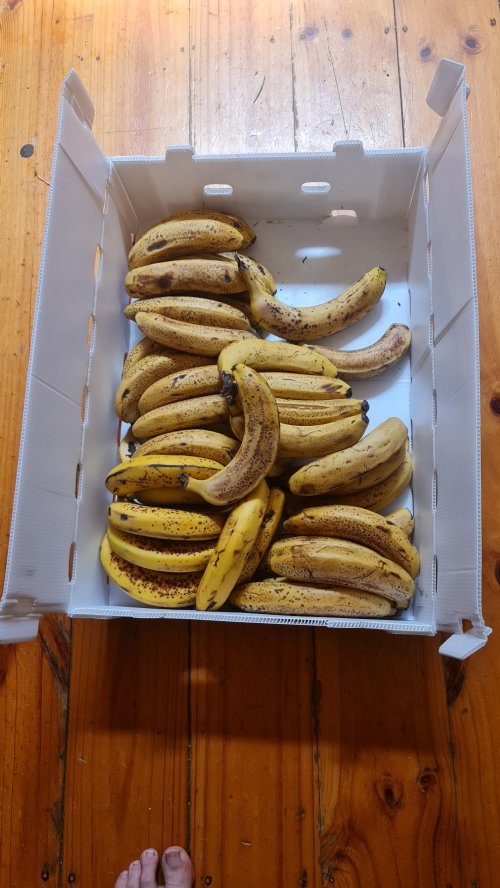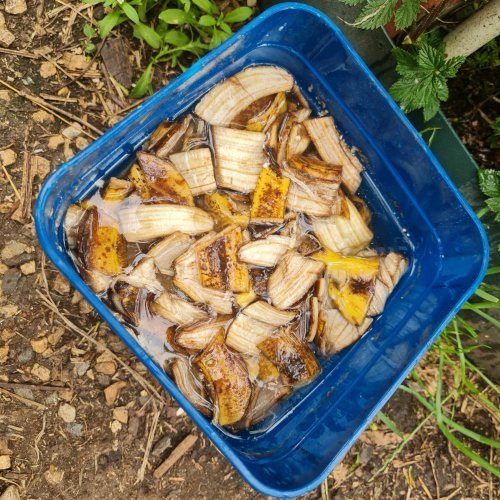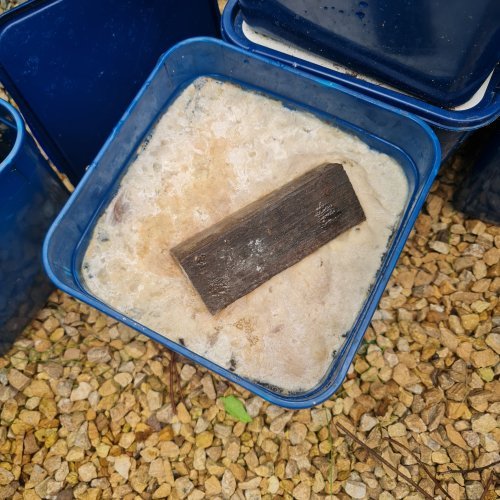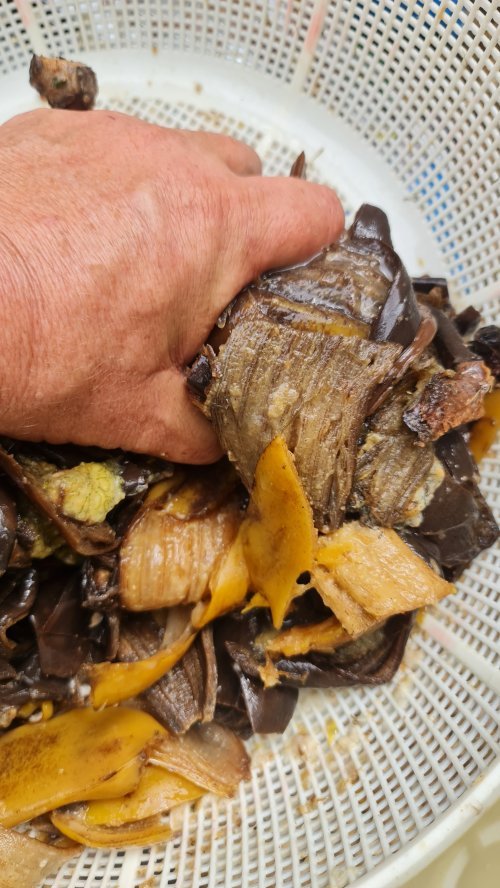How to extract potassium from your leftover banana skins.
Hi Hive DIY and gardening enthusiasts! Here's another simple DIY project from Ligaya Garden. When you've finished reading the post (and hopefully upvoted it), please feel free to comment with any design changes or other uses that you might try for this project.
This one is about how to extract potassium from your leftover banana skins.
Lets' have a look!

I first wrote about using banana skins to give a potassium boost for your plants in Grass Roots No. 264 Apr/May 2021 in an article on making potassium rich liquid fertilizers which is called ‘Make your Flowers Bloom’. Since then I’ve refined my knowledge and technique and taught it in several workshops and demonstrations of home fertilizer making.
I usually hold off posting for a little while after I have an article published and I reckon now is the time to include it here.
Why is potassium important?
Potassium is essential for most organisms because it controls the flow of water into and out of cells. This is particularly important for plants because much of their structure and shape relies on water pressure.
Cell function, metabolism and transpiration all depend on correct water balance, making potassium very important to plant life.
There are many stories about potassium boosting flowering on many plants, including Tomatoes. There is little scientific evidence for this that I can find but I have found that it works. Adding a potassium supplement (‘seems’ – I’ll play it safe here) to boost flowering and fruiting. Maybe it’s because there is a lot of cellular activity involved in flowering and fruiting and that takes water. Possibly, all the potassium is doing is guaranteeing that adequate water is supplied to exactly where it is needed .
Potassium is one of the 3 key nutrients that are always listed on your fertilizer containers. Along with (N)itrogen, (P)hosphorus, K, or Potassium make up the famous NPK ratio. For some reason, potassium is listed as ‘K”, which comes from the Latin ‘Kali-‘ from which it is named.
Banana skins are a ‘waste’ product that is chock full of potassium and it is easy to retrieve it for yourself. All you have to do is ferment the skins. In addition to potassium, banana skins contain magnesium, which is essential for chlorophyll formation (which is the energy source for the plant) and calcium, which is important for strong cell walls. You can see why it’s important not to just compost your banana skins. In the form covered in this post, your minerals will be more immediately accessible and easy to apply in a more targeted manner.
How to make it –

All you need to do to extract potassium and other water soluble compounds from banana skins is to chop your skins into small pieces, cover them with clean water (rainwater is fine) in a covered container and leave it alone for 2 weeks to a month. It’s just like any other kind of ferment. A trick is to weigh down the skins so that they ferment properly below the water surface, letting the anaerobic microbes so their thing.

After a couple of days, sugars will leach out and microbes will get to work breaking down the organic material. What potassium they don’t use goes into solution in the water and when you strain the mix after a couple of weeks, you will have access to it for your plants.
Strain off the liquid (I usually give the pulp a bit of a squeeze to to get all the goodies out) and then let it sit for a while. There will still be some fine sediment in the solution that can clog up sprayer nozzles. It’s so fine that even running it through a coffee filter won’t remove it all. Let it settle, then decant off the clearer liquid above it.




When well fermented, the mixture will have a pH of 4.2 to 4.3, making it pretty acidic. If you add about 20% vinegar (any vinegar) to the total volume, it drops the pH even further, making the brew pretty shelf stable. If you want to store it, do so out of direct sunlight. You may have to open the lid of your bottle from time to time because there will still be a living population of microbes giving off carbon dioxide. If you don’t burp the bottle, when you open it, you will be met with a fountain of liquid, kind of like when you open a shaken up lemonade bottle.
If you forget about your ferment, don’t work, it is pretty forgiving. I’ve left mine a couple of months and it’s been fine when strained out.
How to use your banana liquid –
To use your banana skin extract, all you need is a teaspoonful per litre of water in your watering can if you are watering it in.
For a foliar spray, one tablespoonful per 10 litres is all that is required. To make measuring easy, I mix up 1 tbsp in a watering can (yeah, I know they’re mostly 9 litres nowadays but its close enough), fill my sprayer and water the soil with the rest.
Don’t worry about affecting the pH of your soil with this liquid, the amount that you use is too dilute to cause any problems.
What about the leftovers?
The banana skins will go brown and mushy and a lot of sediment will fall to the bottom of your container. Don’t throw this away, add it to your compost. It can be used on your worm farm too but don’t add it as it is – it’s too acidic!. If you mix it with other materials and sprinkle in some crushed-up eggshells, dolomite or bicarb soda, you will reduce the overall pH and the worms will love you for it.
The strained out sludge goes great in Bokashi bins too!







Thank you for sharing this post on HIVE!
Your content got selected by our fellow curator stevenson7 & you just received a little thank you upvote from us for your great work! Your post will be featured in one of our recurring compilations which are aiming to offer you a stage to widen your audience within the DIY scene of Hive. Next time make sure to post / cross-post your creation within the DIYHub community on HIVE and you will receive a higher upvote ;) Stay creative & HIVE ON!
Please vote for our hive witness <3
Thank you.
!DIY
!discovery 27
This post was shared and voted inside the discord by the curators team of discovery-it
Join our community! hive-193212
Discovery-it is also a Witness, vote for us here
Delegate to us for passive income. Check our 80% fee-back Program
Thank you. It's always exciting to be discovered by a new community
!ALIVE | !BBH | !PGM
@ligayagardener! Your Content Is Awesome so I just sent 1 $BBH (Bitcoin Backed Hive) to your account on behalf of @vocup. (1/20)
BUY AND STAKE THE PGM TO SEND A LOT OF TOKENS!
The tokens that the command sends are: 0.1 PGM-0.1 LVL-0.1 THGAMING-0.05 DEC-15 SBT-1 STARBITS-[0.00000001 BTC (SWAP.BTC) only if you have 2500 PGM in stake or more ]
5000 PGM IN STAKE = 2x rewards!
Discord
Support the curation account @ pgm-curator with a delegation 10 HP - 50 HP - 100 HP - 500 HP - 1000 HP
Get potential votes from @ pgm-curator by paying in PGM, here is a guide
I'm a bot, if you want a hand ask @ zottone444
@ligayagardener! You Are Alive so I just staked 0.1 $ALIVE to your account on behalf of @vocup. (1/20)
The tip has been paid for by the We Are Alive Tribe through the earnings on @alive.chat, feel free to swing by our daily chat any time you want.

Thank you!
Oh I didn't know about this until today ..and here I thought that banana peelings are already a waste.
Thank you for sharing
!PIZZA
No worries!
I gifted $PIZZA slices here:
@curation-cartel(1/20) tipped @ligayagardener (x1)
lhes tipped ligayagardener (x1)
Send $PIZZA tips in Discord via tip.cc!
Thank you!
Wow, this is a very useful blog! Good for my plants and soil. Thank you so much!
Thanks! There's a lot more info on my website ligayagarden.online and past posts here on hive
https://twitter.com/1561752972844863488/status/1597868752208809984
The rewards earned on this comment will go directly to the people( @jijisaurart ) sharing the post on Twitter as long as they are registered with @poshtoken. Sign up at https://hiveposh.com.
Thanks for sharing it to another platform @jijisaurart
Super interesting. I have been throwing a banana 🍌 skin in when I plant tomatoes. Is that a dumb thing to do?
And what does this fermented banana goodness smell like?
It's not at all a bad thing. The nutrients get there eventually.
Fermented Bamaga goodness smells like ...
For my first time, of seeing this that banana 🍌 peel contain a lot of potassium. I will also try on my crops and see how it works. Thanks for the detailed write up!
No worries! Let us all know your results
Creative way !! interesting

!1UP
Thank you very much!
You have received a 1UP from @gwajnberg!
@stem-curator, @vyb-curator, @pob-curator
And they will bring !PIZZA 🍕.
Learn more about our delegation service to earn daily rewards. Join the Cartel on Discord.
Thank you @curation-cartel and @gwajnberg
Congratulations @ligayagardener! Your post has been a top performer on the Hive blockchain And you have been rewarded with the following badge
You can view your badges on your board and compare yourself to others in the Ranking
If you no longer want to receive notifications, reply to this comment with the word
STOPCheck out the last post from @hivebuzz:
Hooray!
Congrats, keep going like this @ligayagardener 😉 Have a nice day!
Yes, you are right. There are many valuable things in things that we don't even think about. We can really benefit from banana peels. Also, you can use the discarded tea powder.Of course, we can make good fertilizer from natural things removed at home without spending any money
Thanks for sharing @ligayagardener
No worries!
Thanks @stevenson7 and @diyhub